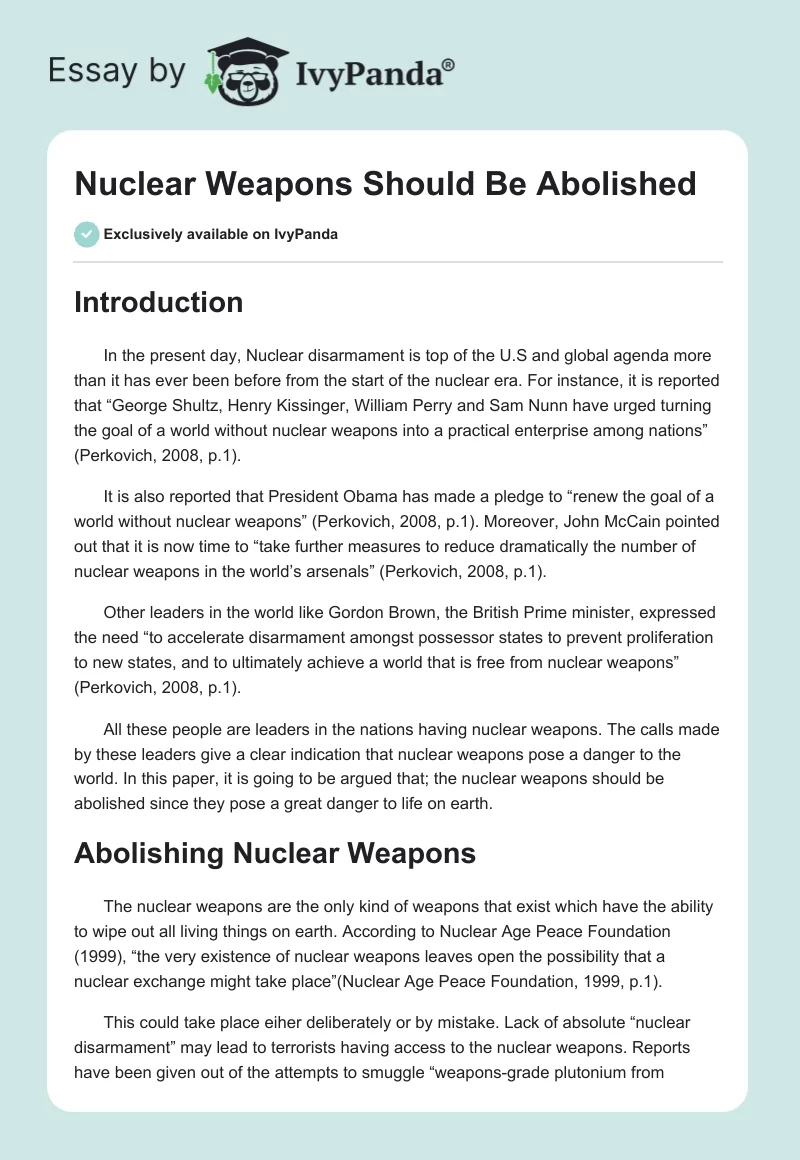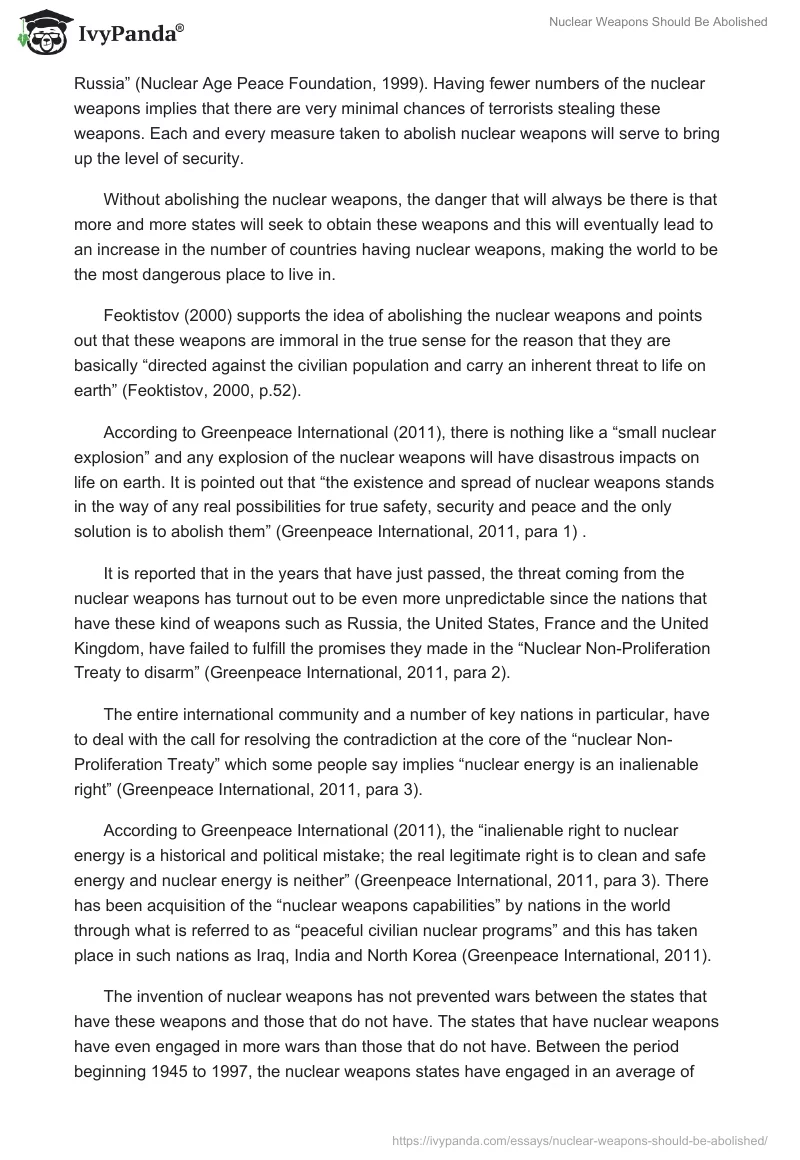Introduction
In the present day, Nuclear disarmament is top of the U.S and global agenda more than it has ever been before from the start of the nuclear era. For instance, it is reported that “George Shultz, Henry Kissinger, William Perry and Sam Nunn have urged turning the goal of a world without nuclear weapons into a practical enterprise among nations” (Perkovich, 2008, p.1).
It is also reported that President Obama has made a pledge to “renew the goal of a world without nuclear weapons” (Perkovich, 2008, p.1). Moreover, John McCain pointed out that it is now time to “take further measures to reduce dramatically the number of nuclear weapons in the world’s arsenals” (Perkovich, 2008, p.1).
Other leaders in the world like Gordon Brown, the British Prime minister, expressed the need “to accelerate disarmament amongst possessor states to prevent proliferation to new states, and to ultimately achieve a world that is free from nuclear weapons” (Perkovich, 2008, p.1).
All these people are leaders in the nations having nuclear weapons. The calls made by these leaders give a clear indication that nuclear weapons pose a danger to the world. In this paper, it is going to be argued that; the nuclear weapons should be abolished since they pose a great danger to life on earth.
Abolishing Nuclear Weapons
The nuclear weapons are the only kind of weapons that exist which have the ability to wipe out all living things on earth. According to Nuclear Age Peace Foundation (1999), “the very existence of nuclear weapons leaves open the possibility that a nuclear exchange might take place”(Nuclear Age Peace Foundation, 1999, p.1).
This could take place eiher deliberately or by mistake. Lack of absolute “nuclear disarmament” may lead to terrorists having access to the nuclear weapons. Reports have been given out of the attempts to smuggle “weapons-grade plutonium from Russia” (Nuclear Age Peace Foundation, 1999). Having fewer numbers of the nuclear weapons implies that there are very minimal chances of terrorists stealing these weapons. Each and every measure taken to abolish nuclear weapons will serve to bring up the level of security.
Without abolishing the nuclear weapons, the danger that will always be there is that more and more states will seek to obtain these weapons and this will eventually lead to an increase in the number of countries having nuclear weapons, making the world to be the most dangerous place to live in.
Feoktistov (2000) supports the idea of abolishing the nuclear weapons and points out that these weapons are immoral in the true sense for the reason that they are basically “directed against the civilian population and carry an inherent threat to life on earth” (Feoktistov, 2000, p.52).
According to Greenpeace International (2011), there is nothing like a “small nuclear explosion” and any explosion of the nuclear weapons will have disastrous impacts on life on earth. It is pointed out that “the existence and spread of nuclear weapons stands in the way of any real possibilities for true safety, security and peace and the only solution is to abolish them” (Greenpeace International, 2011, para 1) .
It is reported that in the years that have just passed, the threat coming from the nuclear weapons has turnout out to be even more unpredictable since the nations that have these kind of weapons such as Russia, the United States, France and the United Kingdom, have failed to fulfill the promises they made in the “Nuclear Non-Proliferation Treaty to disarm” (Greenpeace International, 2011, para 2).
The entire international community and a number of key nations in particular, have to deal with the call for resolving the contradiction at the core of the “nuclear Non-Proliferation Treaty” which some people say implies “nuclear energy is an inalienable right” (Greenpeace International, 2011, para 3).
According to Greenpeace International (2011), the “inalienable right to nuclear energy is a historical and political mistake; the real legitimate right is to clean and safe energy and nuclear energy is neither” (Greenpeace International, 2011, para 3). There has been acquisition of the “nuclear weapons capabilities” by nations in the world through what is referred to as “peaceful civilian nuclear programs” and this has taken place in such nations as Iraq, India and North Korea (Greenpeace International, 2011).
The invention of nuclear weapons has not prevented wars between the states that have these weapons and those that do not have. The states that have nuclear weapons have even engaged in more wars than those that do not have. Between the period beginning 1945 to 1997, the nuclear weapons states have engaged in an average of about five wars and, on the other hand, the non-nuclear weapons states have had an average of 0.62 wars (Nuclear Age Peace Foundation, 1999).
Those who do no support the idea of abolishing the nuclear weapons present claims that, weapons like these have at least prevented “large-scale conflict” between the superpowers and especially between the former USSR and the United States (Nuclear Age Peace Foundation, 1999).
However, although no more world wars have come up beginning from the time the nuclear weapons were developed and their use started, this is not evidence sufficient to indicate that they are the nuclear weapons that are responsible for maintaining the peace. It is not clear that any of the superpowers had intentions of engaging in war with each other on a large scale.
It is also pointed out that not all American leaders support the idea that the world without nuclear weapon is desirable (Perkovich, G. & Acton, 2009). An argument was presented by John Deutch and Harold Brown, both of whom are former Democratic cabinet secretaries, that “the goal, even the inspirational goal, of eliminating all nuclear weapons is counterproductive” (Perkovich, 2008, p.1).
It is also insisted by John Kyl, a Republican Senator, that “U.S national security – and that of our allies – will not permit a nuclear-free world in the foreseeable future” (Perkovich, 2008, p.2). But on the other hand, considering the idea that nuclear weapons pose and great danger to the world, having the ability to wipe any form of life on earth, these weapons needs to be completely abolished and other options sought.
Conclusion
The nuclear weapons should be abolished since they pose a great danger to life on earth. These weapons are capable of destroying any form of life on earth. Failing to abolish them and allowing them to be held by more states increases the danger. This may also make it possible for the terrorists to obtain these weapons, and may in turn use them wrongly to destroy life. The best solution is to abolish the nuclear weapons in order to have peace, security and safety on earth.
References
Feoktistov, L. (2000). Nuclear weapons can and must be banned: The view from Russia. Nuclear Non-proliferation Treaty Review Conference 2000. Web.
Greenpeace International, (2011). Abolish nuclear weapons. Web.
Nuclear Age Peace Foundation, (1999). Six arguments for abolishing nuclear weapons. Nonukes. Web.
Perkovich, G. (2008). Abolishing nuclear weapons: Why the United States should lead. Washington D.C: Carnegie Endowment for International Peace.
Perkovich, G. & Acton, J. M. (2009). Abolishing nuclear weapons: A debate. Washington D.C: Carnegie Endowment for International Peace.


